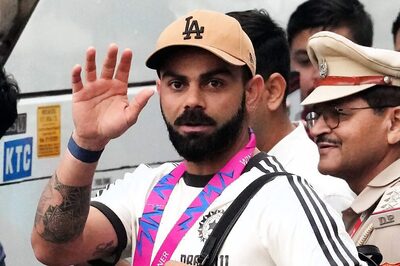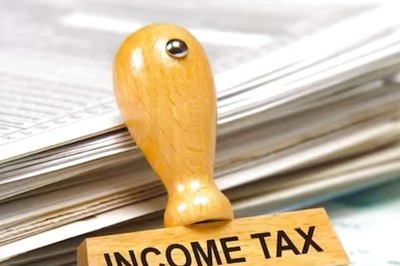
views
New Delhi: Chilling details about extensive plots to strike high profile and sensitive targets in India are coming out in the closely-watched trial of Pakistani-born businessman Tahawwur Rana who is charged with helping the Lashkar-e-Taiba plan the 2008 strikes that killed 160 people.
The documents that have come to light in trial of Rana show how the Lashkar plotted attacks, in great details, on India’s nuclear installations, Jewish organizations and crowded markets. The emails, transcripts, recce videos and photos also show a plan to target Bal Thackeray, the head of the Shiv Sena while exposing the links between Pakistan's Inter-Services Intelligence directorate (ISI) and elements in Pakistan's military with the terror outfit.
The trial also put on stand David Coleman Headley, the LeT operative who is said to have scouted targets across the length and breadth of India in his nine visits to the country, including detailed reconnaissance of the National Defence College, Chabad houses in Goa, Delhi, Mumbai and Pune and the Bhaba Atomic Research Centre.
Headley has said Pakistan's Inter-Services Intelligence directorate (ISI) and elements in Pakistan's military coordinated with Lashkar and other Pakistani militants to launch the daring attacks on Mumbai.
The gradually unravelling terror trail links Headley to his various contacts in India, according to emails, photos, videos and transcripts and other documents related to the trial of Rana put up as trial exhibits by the United States Attorney's Office for the Northern District of Illinois on its website.
On exhibit are Headley's email exchanges with Raja Rege, who he refers to as the ‘Shiv Sena PRO’ as part of a bigger plot to get access to Shiv Sena supremo Bal Thackeray, high on the LeT list as a possible target.
Rege writes in June 2008 to Headley asking for details of his company and the work done so far and agrees to his visit to India in the coming weeks to set up a 'business opportunity' with the Shiv Sena chief. Rege calls Headley ‘Dave’ and boasts of contacts in India and the scope that lies in various projects.
Headley promptly forwards the mail to one 'Chaudhery Khan' who he identifies as Major Iqbal, an ISI officer.
Writing from an email id '[email protected]' and 'ranger1dave2yahoo.com', Headley also discusses funds and cash transactions with Rana in emails dated March 2007, about the time he visited India.
According to a document, Headley got his name changed from Dawood Gilani in February 2006 to David Coleman Headley.
He updates Major Iqbal in an email sent in April 2008 on commercially viable spy cameras and surveillance material.
One of Headley's conversations with Pasha months after the Mumbai raid turned to Headley's anger at a man identified as Major Iqbal of Pakistan's ISI, who had provided guidance during Headley's surveillance work in Mumbai.
He called Iqbal a "coward" for telling Headley, "Friend, do not have any contact with me any more."
According to the National Investigation Agency’s interrogation report, Headley gives an extensive report of his nine visits to India and his reconnaissance in places such as Paharganj in Delhi, the Taj Hotel in Mumbai and identifying places for the Mumbai attackers to land after crossing over on boats from Pakistan.
Headley, who has been put under witness protection programme of the federal government and is being treated as a star witness in the trial of Tahawwur Rana Hussein Rana, admitted that his reconnaissance videos on the five targets in Mumbai which were attacked on 26/11 were crucial for the success of the LeT.
His reconnaissance videos in respect of other targets in Mumbai, Delhi, Pune, Goa and Pushkar was intended for use by the LeT to attack India and cause large scale damage.
The report clearly states that the money which was used by Headley for reconnaissance was provided by Major Iqbal.
During conversation with Abdur Rehman Hashim Pasha in 2009, Headley believed an attack on the National Defence College is imminent. After his training Headley was told to go to India and several Indian cities were discussed – Kolkata, Delhi, Bangalore Pune, Nagpur, Gujarat and Hyderabad.
From his first visit to his ninth visit to India, Headley carried a camera he had taken from his mother-in-law in Pakistan.
Headley said during his visit to India in April and June 2008, he carried a Sony Eriksson model of mobile phone given to him by Major Iqbal and GPS device given to him by Sajid Majid, one of the earliest members of LeT.
Headley conducted detailed videography of places for future attacks including residence of the Vice President of India, India Gate, Paharganj in Delhi and the CBI office in Mumbai. Headley identified some of the prominent locations on Google Earth.
In 2005 Headley was getting impatient after having completed his training which included hand to hand combat and wanted to be sent to Kashmir. He, however, was told to wait.
Between October and December 2005 Headley said the LeT conducted a surveillance of the Rajkot Oil refinery, a possible target.
September 14 2006 to December 14 2006
During his first visit to India he stayed at Hotel Outram in Mumbai. He purchased a cell phone and a sim card. He bought memory sticks from a showroom near his hotel. He befriended Rahul Bhatt during this time.
Headley said he made extensive photography of the Bombay Municipal Corporation building, Haji Ali, Gateway of India, Hotel Taj, the Apollo Bander, State Police Headquarters of Maharashtra, Azad Maidan, areas close to hotel Outram, and Marine Drive.
Headley watched videos of Kumbh Mela and was asked by Sajid if these places could be attacked.
On his second visit to India in February 2007, a third in March, 2007, and fourth in May 2007 he said he made some general videography of the city.
His fifth visit to India
In September 2007, he came to India for the fifth time and this time the target was Pune. He conducted a reconnaissance of the NDC in Delhi. In Mumbai he made a detailed surveillance of the entry and exit points of the Taj Hotel, the jewellery shop 'Jazdar' of the Taj hotel. The Shiv Sena Bhavan was videographed as Headley visited the house of Bal Thackeray and spoke to some guards.
He was also asked to do a recce of the staff colony of the Bhaba Atomic Research Centre. In April 2008, his seventh visit, he videographed the entire BARC residential areas, believed to be one of Asia's largest. He also conducted boat rides for reconnaissance of the landing sites. He went to Cuffe Parade area where the attackers finally landed.
He also conducted a reconnaissance of the VT railway station and a bus terminus near VT. He took videos of the Mumbai central railway station. He discussed his surveillance with Rana who told him of an Indo-Pak agreement on non-use of force on each others’ nuclear installation.
Detailed maps of Mumbai, images of operatives, the landing sites in Mumbai for terror operatives were submitted as evidence in the trial as Headley said told the US District Court jury about secretly recorded telephone conversations he had with Rana and retired Pakistan military officer Abdur Rehman, known as Pasha.
Headley said he and Rana gloated over the success of the Mumbai raids and praised its planners, listening to recordings of cell phone conversations between the attackers and Headley's main Lashkar contact, Sajid Mir, during the raid.
In July 2008, Headley said he finalized his surveillance of the the Taj hotel, naval air station, police HQ, state assembly building, Siddhi Vinayak Temple, Chabad House, Mumbai Stock Exchange, Leopold Cafe, Colaba police station, Delhi Durbar, Israeli consulate, DN Road and Trident Hotel. He covered the VT railway station and the bus stand to plot an exact egress point for the attackers.
It was at this time that he went to Osho Ashram in Pune and bought a gown. During the discussion for the boat ride he suggested the attackers wear vests which he said saved them during a botched attempt in September 2008. He said he wanted to name the Mumbai attacks the Mickey Mouse Project but Sajid did not like the name and renamed it Northern Project.
When back in Pakistan in June 2008 Headley said he was getting frustrated due to the lack of action. He met Sajid and Abu Quhafa and it was decided that the sea route was to be used to go to Mumbai. He was asked to take a stock of train timings at the VT railway station. The Taj Presidency, World Trade Centre, Chabad House, Maharashtra Police Station, State Assembly Building, Bombay Stock Exchange and the Radio Club were discussed as possible targets.
Soon after, in October Headley shifted to Denmark for a reconnaissance. He said he watched the Novenmer 26, 2008 attacks on Geo TV and CNN.
While videographing the Raksha Bhawan, he also videographed the outer boundary of the Prime Minister's residence.
He informed the handlers that the best time to attack Pushkar was in winter and they could hide weapons in surrounding mountains. He was shown a oil refinery on Google Earth, possibly the Reliance Oil Refinery near Gujarat.
On his final trip to India in 2009, Headley conducted reconnaissance of Chabad Houses in Delhi, Pushkar, Goa and Pune. He took videos of all three entry points to Delhi's crowded Paharganj area. He visited India Gate and surveyed the Vice Presidents house, Sena Bhawan and NDC and made extensive footage of Israeli embassy and entries to NDC.
Paharganj looked like a likely target. His last visit also brought him to Pune where he extensively surveyed the entire Koregaon area, including the German Bakery.####Headley’s emailsZoomZoom
Photos
Video

















Comments
0 comment